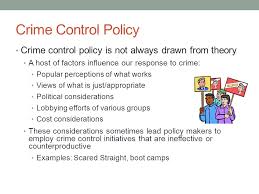Abstract:
The future of crime control policies in the United States is a topic of great importance, as the nation grapples with evolving challenges in law enforcement ,criminal justice, and social dynamics. This essay delves into the current landscape of crime control policies, identifies emerging trends, and discusses potential avenues for reform and improvement. By analyzing technological

advancements, shifts in societal attitudes, and the intersection of various factors influencing
crime, this essay provides insights into shaping effective strategies to address crime in the future.
Introduction:

Crime control policies in the United States have undergone significant transformations over the years, influenced by societal changes, technological advancements, and shifts in political ideologies. As the nation navigates complex challenges related to crime, including cybercrime, mass shootings, and racial disparities in law enforcement, it becomes imperative to examine the trajectory of crime control policies and explore innovative approaches for the future.
This essay aims to explore the future of crime control policies in the United States by analyzing current trends, emerging challenges, and potential avenues for reform. By examining the intersection of various factors shaping crime, including technology, social dynamics, and institutional frameworks, this essay seeks to provide a comprehensive understanding of how crime control policies can adapt to meet the needs of a rapidly changing society.
Current Landscape of Crime Control Policies:
The current landscape of crime control policies in the United States is characterized by a mix of traditional approaches and innovative strategies. Historically, crime control has been predominantly focused on reactive measures, such as law enforcement patrols, arrests, and incarceration. However, in recent years, there has been a growing recognition of the limitations of these approaches, particularly in addressing root causes of crime and reducing recidivism rates.
One of the key pillars of contemporary crime control policies is community policing, which emphasizes collaboration between law enforcement agencies and local communities to prevent crime and build trust. Community policing initiatives often involve community outreach programs, neighborhood watch groups, and partnerships with social service organizations to address underlying issues contributing to crime, such as poverty, substance abuse, and mental health problems.
Additionally, there has been an increasing emphasis on data-driven approaches to crime control, leveraging technology and predictive analytics to identify crime hotspots, allocate resources effectively, and target interventions. Techniques such as CompStat, which uses statistical analysis to track crime trends and hold law enforcement agencies accountable for performance, have gained prominence in many jurisdictions.
Emerging Trends and Challenges:
Despite advancements in crime control policies, several emerging trends and challenges pose significant obstacles to effective crime prevention and enforcement in the United States. One such trend is the rise of cybercrime, fueled by the proliferation of digital technologies and the interconnectedness of modern society. Cybercrime encompasses a wide range of activities, including hacking, identity theft, online fraud, and cyber terrorism, posing unique challenges for law enforcement agencies in terms of detection, investigation, and prosecution.
Another emerging challenge is the prevalence of mass shootings and domestic terrorism incidents, which have escalated in frequency and severity in recent years. These incidents highlight the complex interplay of factors contributing to violent extremism, including ideological radicalization, access to firearms, and mental health issues. Addressing this challenge requires a multifaceted approach that combines law enforcement efforts with community engagement, mental health services, and gun control measures.
Furthermore, racial disparities in the criminal justice system continue to be a pervasive issue, with African Americans and other marginalized communities disproportionately impacted by discriminatory policing practices, harsh sentencing policies, and systemic inequities. The Black Lives Matter movement and other advocacy groups have brought attention to these disparities, calling for reforms to promote accountability, transparency, and racial justice within law enforcement agencies and the legal system.
Future Directions for Crime Control Policies:
In light of these trends and challenges, the future of crime control policies in the United States will likely be shaped by a combination of technological innovations, policy reforms, and shifts in societal attitudes. One potential direction for the future is the expansion of proactive, preventive approaches to crime control, focusing on early intervention and addressing underlying risk factors before they escalate into criminal behavior.
This may involve investments in education, job training, and social services to provide at-risk individuals with alternatives to crime and pathways to success. Additionally, leveraging technology and data analytics can enhance law enforcement capabilities in identifying and disrupting criminal networks, while also safeguarding civil liberties and privacy rights.
Furthermore, there is a growing recognition of the need for holistic, evidence-based approaches to criminal justice reform that prioritize rehabilitation, reintegration, and community reintegration for individuals involved in the criminal justice system. This includes expanding access to mental health treatment, substance abuse counseling, and job placement services to address the underlying drivers of criminal behavior and reduce recidivism rates.
Moreover, addressing systemic inequalities and racial disparities within the criminal justice system will be essential for building trust and legitimacy in law enforcement institutions. This may involve implementing policies to promote diversity and cultural competence within police departments, as well as adopting accountability mechanisms to prevent and address instances of racial bias and misconduct.

Conclusion:
The future of crime control policies in the United States will be shaped by a complex interplay of factors, including technological advancements, social dynamics, and political priorities. By embracing proactive, preventive approaches to crime, leveraging technology and data analytics, and addressing systemic inequalities within the criminal justice system, policymakers can work towards building safer, more equitable communities for all. However, achieving meaningful progress will require collaboration and collective action across multiple stakeholders, including government agencies, law enforcement, community organizations, and the public. Through sustained efforts and innovative strategies, the United States can strive towards a future where crime is effectively addressed, justice is served, and communities thrive.



